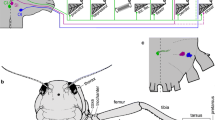Summary
-
1.
In intactHomarus gammarus, the swimmeret motor patterns present during the startle response and in gravid females, are very different. Kinetics and electromyograms (EMGs) reveal that the major difference is that the curler muscles of the rami (endopodite and exopodite) are active in the first response and silent in the second (Figs. 2, 3, 4).
-
2.
An in vitro preparation has been used (Fig. 1) to analyze the activity of the curler motor neurons (MNs). In this preparation, all peripheral structures have been kept intact. This allowed us to show that the curler MNs axons run through root Ia (Fig. 5).
-
3.
The in vitro preparation is sometimes spontaneously rhythmic. An individual curler MN is active either during the powerstroke (PS) or the returnstroke (RS) of the swimmeret rhythm (Fig. 6). There are more ‘PS’ curler MNs than ‘RS’ curler MNs.
-
4.
Curler MNs active in the same stroke are often electrically coupled regardless of the ramus that they innervate (Fig. 8).
-
5.
Sensory activity from a swimmeret ramus strongly modifies the activities of the curler MNs of the two rami as well as those of other swimmeret MNs (Fig. 9). In rhythmic preparations, periodic electrical stimulation can entrain the MN rhythm within a certain range of stimulus frequencies (Figs. 10, 11).
-
5.
Thus, the curler MNs from both rami are linked centrally (electrical coupling) and peripherally (sensory afferents activated by movement). These two mechanisms synchronize the activities of the two rami.
Similar content being viewed by others
Abbreviations
- CPG :
-
central pattern generator
- EJP :
-
excitatory junctional potential
- EMG :
-
electromyogram
- EPSP :
-
excitatory postsynaptic potential
- IJP :
-
inhibitory junctional potential
- MN :
-
motor neuron
- PS :
-
powerstroke
- PSc MN :
-
powerstroke curler motor neuron
- RS :
-
returnstroke
- RSc MN :
-
returnstroke curler motor neuron
- VNC :
-
ventral nervous cord
References
Ayers JL, Selverston AI (1979) Monosynaptic entrainment of an endogenous pacemaker network: a cellular mechanism for Von Holst's magnet effect. J Comp Physiol 129:5–15
Cattaert D, Clarac F (1983) Influence of walking on swimmeret beating in the lobsterHomarus gammarus. J Neurobiol 14:421–440
Cohen JL, Weiss KR, Kupffermann I (1978) Motor control of buccal muscles inAplysia. J Neurophysiol 41:157–180
Davis WJ (1968) The neuromuscular basis of lobster swimmeret beating. J Exp Zool 168:363–378
Davis WJ (1969) Reflex organization in the swimmeret system of the lobster. I. Intrasegmental reflexes. J Exp Biol 51:547–563
Davis WJ (1971) Functional significance of motoneuron size and soma position in swimmeret system of the lobster. J Neurophysiol 34:274–288
Davis WJ, Kennedy D (1972) Command interneurons controlling swimmeret movements in the lobster. I. Types of effects on motoneurons. J Neurophysiol 35:1–19
Heitler WJ (1978) Coupled motor neurons are part of the crayfish swimmeret central oscillator. Nature 275:231–234
Heitler WJ (1982) Non spiking stretch receptor in the crayfish swimmeret system. J Exp Biol 96:355–366
Heitler WJ (1983) The control of rhythmic limb movements in Crustacea. In: Roberts A, Roberts B (eds) Neural origin of rhythmic movements. Soc Exp Biol 37:351–381
Heitler WJ (1986) Aspects of sensory integration in the crayfish swimmeret system. J Exp Biol 120:387–402
Heitler WJ, Pearson KG (1980) Non spiking interactions and local interneurons in the C.P.G. of the crayfish swimmeret system. Brain Res 187:206–211
Hughes GM, Wiersma CAG (1960) Coordination of swimmeret movements in the crayfishProcambarus clarkii (Girard). J Exp Biol 37:657–670
Ikeda K, Wiersma CAG (1964) Autogenic rhythmicity in the abdominal ganglia of the crayfish: the control of swimmeret movements. Comp Biochem Physiol 12:107–115
Killian KA, Page CH, Cipolla DA (1985) Efferent neurons of the abdominal pleopods in the lobster,Homarus americanus: sexual dimorphism and segmental variation. Soc Neurosci Abstr 11:511
Kotak VC, Page CH (1986) Tactile stimulation of the swimmeret alters motor programs for abdominal posture in the lobsterHomarus americanus. J Comp Physiol A 158:225–235
Marrelli JD, Hsiao HS (1976) Miniature angle transducer for marine arthropods. Comp Biochem Physiol 54A:121–123
Möhl B (1985) The role of proprioception in locust flight control. III. The influence of afferent stimulation of the stretch receptor nerve. J Comp Physiol A 156:281–291
Paul DH, Mulloney B (1985) Local interneurons in the swimmeret system of the crayfish. J Comp Physiol A 156:489–502
Pearson KG, Reye DN, Robertson RM (1983) Phase dependent influences of wing stretch receptors on flight rhythm in the locust. J Neurophysiol 49:1168–1181
Stein PSG (1971) Intersegmental coordination of swimmeret motoneuron activity in the crayfish. J Neurophysiol 34:310–318
Wendler G (1974) The influence of proprioceptive feedback on locust flight co-ordination. J Comp Physiol 88:173–200
West L, Jacobs G, Mulloney B (1979) Intrasegmental proprioceptive influences on the period of the swimmeret rhythm in the crayfish. J Exp Biol 82:281–288
Wiersma CAG, Ikeda K (1964) Interneurons commanding swimmeret movements in the crayfish,Procambarus clarkii (Girard). Comp Biochem Physiol 12:509–525
Williams BJ, Larimer JL (1981) Neural pathways of reflexevoked behaviors and command systems in the abdomen of the crayfish. J Comp Physiol 143:27–42
Author information
Authors and Affiliations
Rights and permissions
About this article
Cite this article
Cattaert, D., Clarac, F. Rami motor neurons and motor control of the swimmeret system ofHomarus gammarus . J. Comp. Physiol. 160, 55–68 (1987). https://doi.org/10.1007/BF00613441
Accepted:
Issue Date:
DOI: https://doi.org/10.1007/BF00613441




